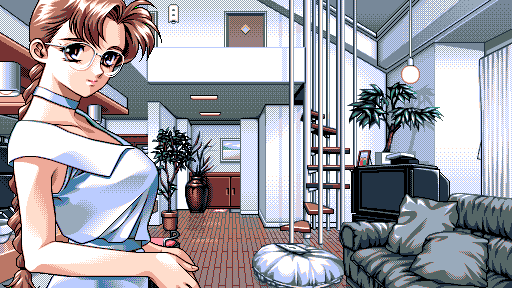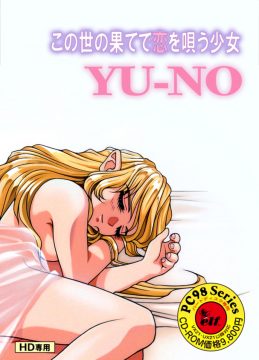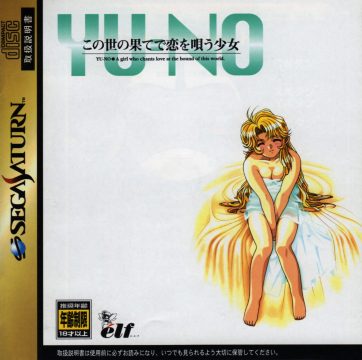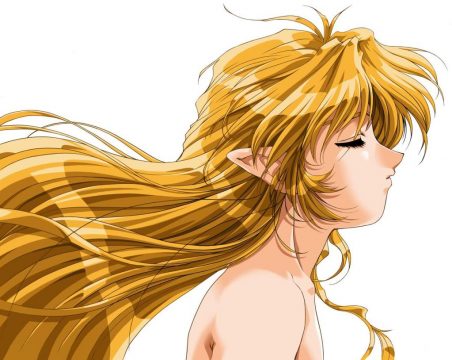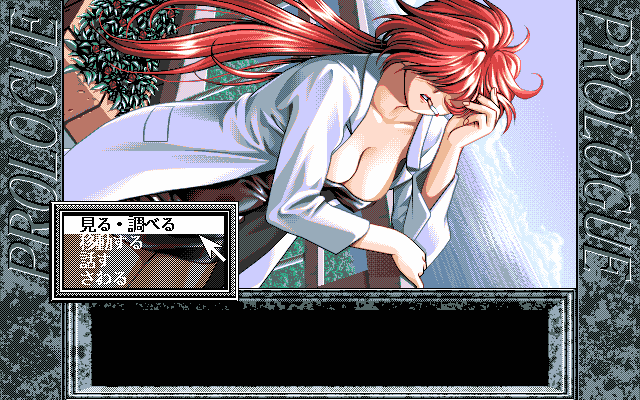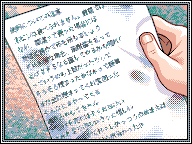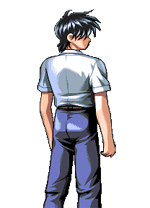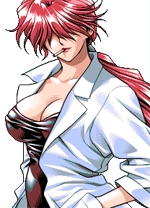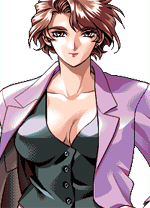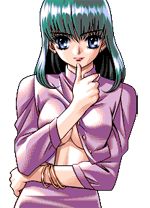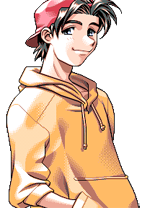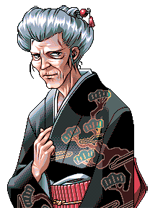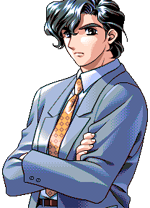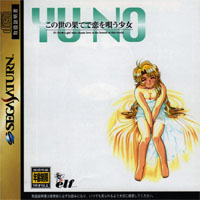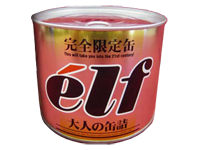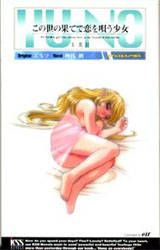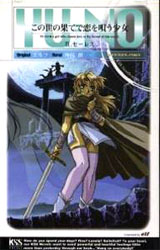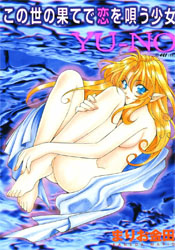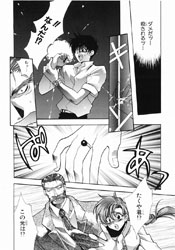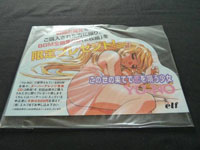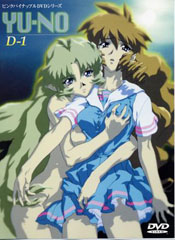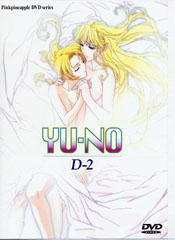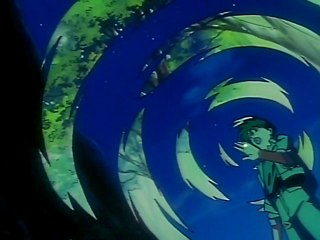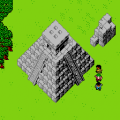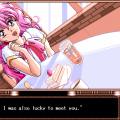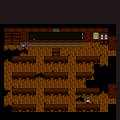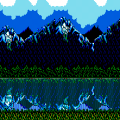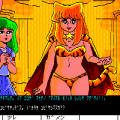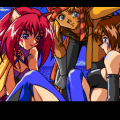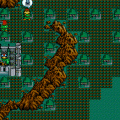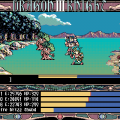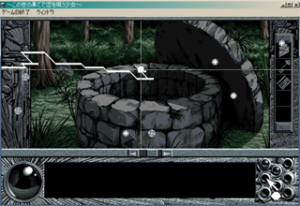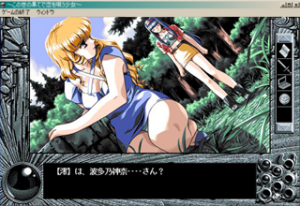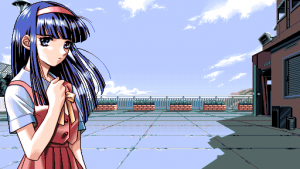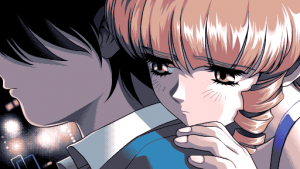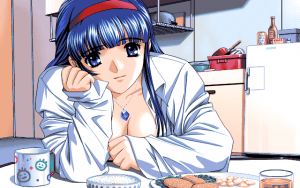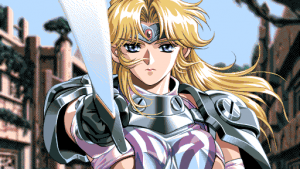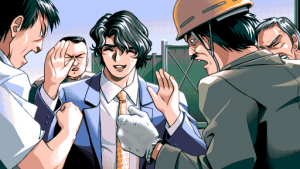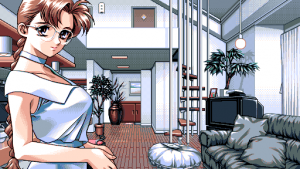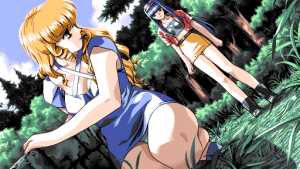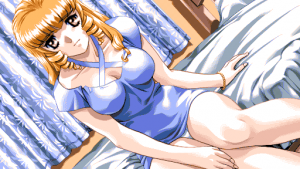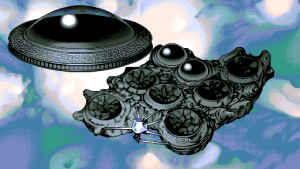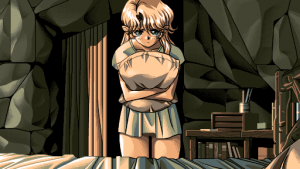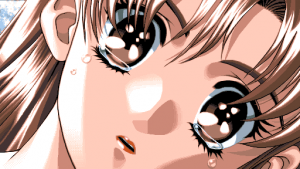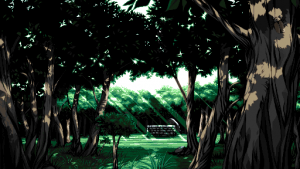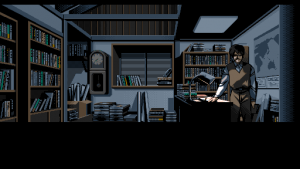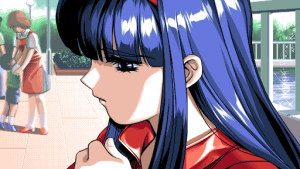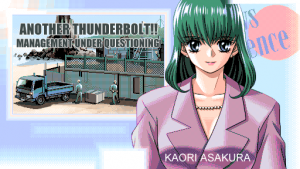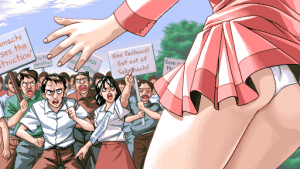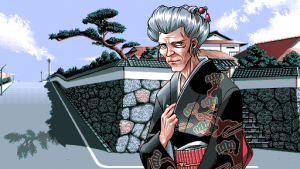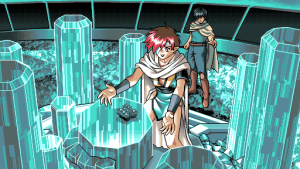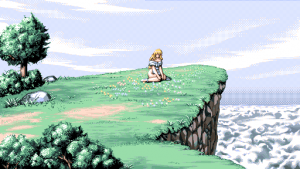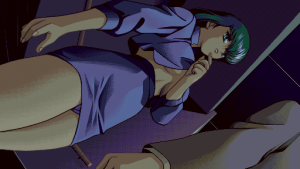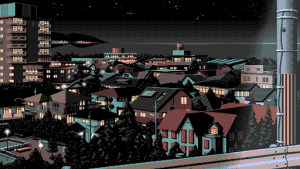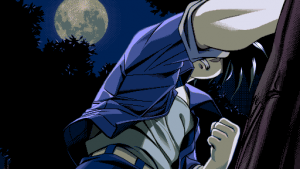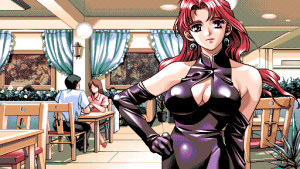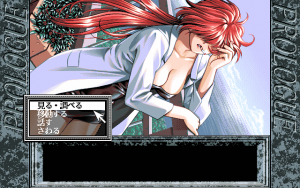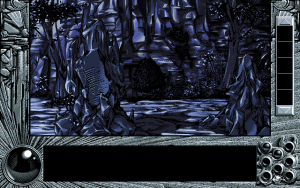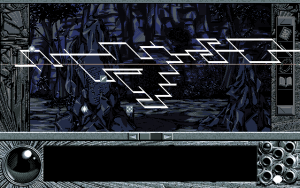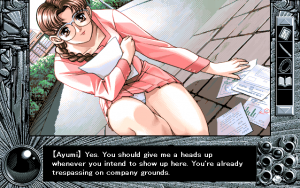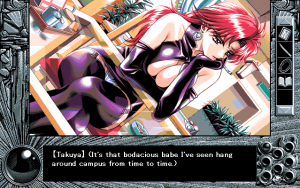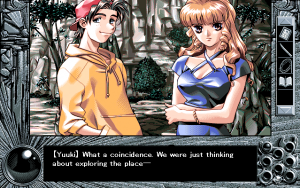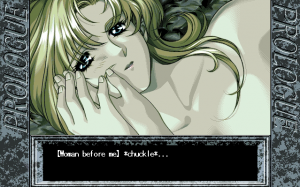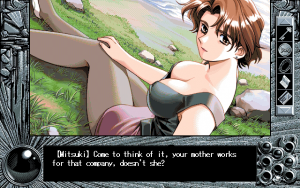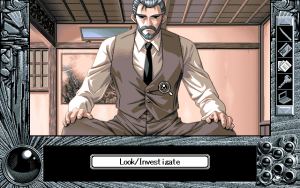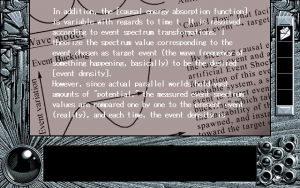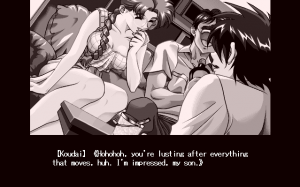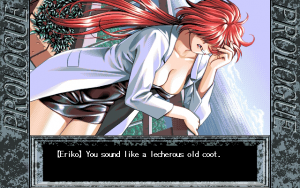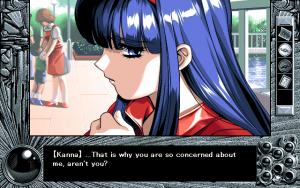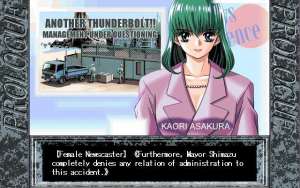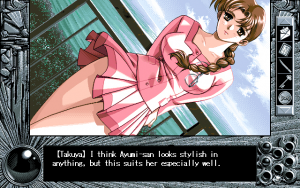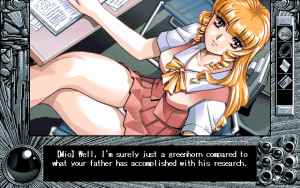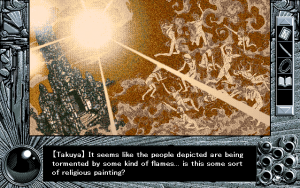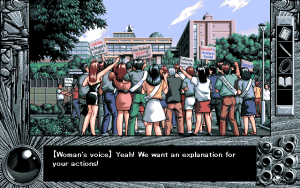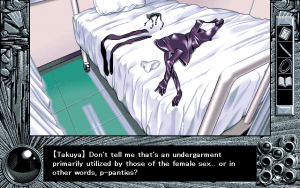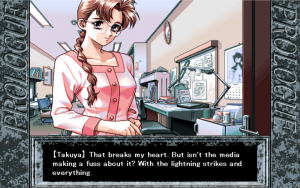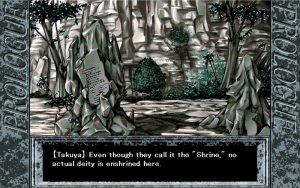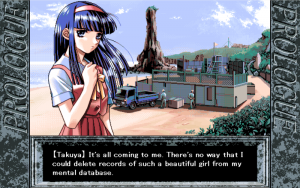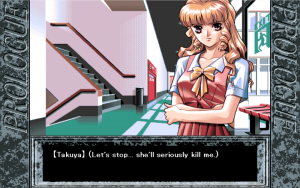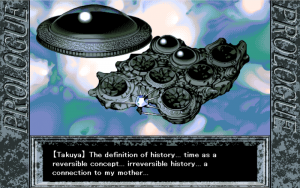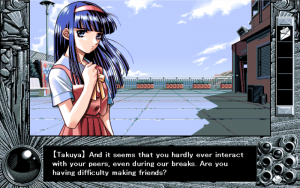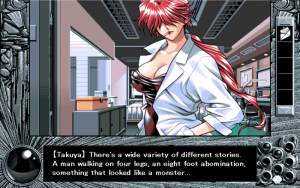No matter how many times one introduces visual novels to a Western audience, the initial response will largely be the same: Porn. Now naturally, the genre has been largely dominated with adult content since it came to fruition, and to this very day, 80 percent of adult material produced in Japan is in the form of manga and visual novels, which is a quite staggering number considering how large the industry is in the relatively small country. But as a genre, visual novels have the potential to be incredibly prosperous and diverse, allowing for as much versatility as your common day 3rd person action game. Like anything else, you need clear direction and new thinking if you want to change the playing field.
By 1994, visual novels by and large had despite its young age gone frustratingly stale. In its most basic form, the novels allowed for a very speedy and cheap production time, allowing small sized companies to churn out several games a month to make a profit, flooding the market with subpar products lacking in all aspects, visual, audio and story telling. While the games sold to the common lusty mind, enthusiasts who were looking to be emotionally and intellectually challenged had to look quite far to find anything that would even hold up to their lowest standards. It was simply too easy to draw six still frames and recycle them to fit the dialogue before ending in the inevitable ‘crazy eyed moose dance” in the sack. The games were short, cliched and had turned into simple excuses to look at naked women.
Change was definitely needed, but change required a lot more than just merely writing a better story than the competition. Selling to a narrow window of enthusiast won’t convince studios to cough up the necessary funds, and the rest of the market had to be convinced that there was more to the genre than the sex. Enter Hiroyuki Kanno. Wait, that sounds dirty…
Kanno was a young scenario writer at C’s Ware who was eager to craft his own stories in a form of video game. His studies had been sidetracked by his two primary loves in life, reading and video games. At every waking hour, Kanno would read Sir Arthur Conan Doyle and crime pulp, while at night he would play Ultima and Elf’s Doukyousei for hours at end. He had always been drawn to mystery, and would draw scenarios that he one day dreamt to put into his very own video games. C’s Ware started their company in 1993 in the wake of the stagnant state of visual novels, eager to make that change it so sorely needed and set out to find young, hungry talent. Being a start up company, their budget constrains forced them to seek carefully and be efficient in their hiring. This lead them to a young sound designer who had impressed throughout his freelance career with both his composition and programming work; Ryu Umemoto. The young man proved to be perfect for what they wanted, a young, eager talent who could compose and program his own sound drivers and tools, effectively keeping costs down. The marriage of Kanno’s visionary way of storytelling and Umemoto’s incredible melodic range would soon revolutionize visual novels with a trifecta of works: Desire, Xenon and Eve burst error. Kanno wanted to break all the molds of visual novels, and under his lead which increased by each game released, the game engines were extensively scripted and programmed. Suddenly, the emphasis was put solely on the way the story was told, and sex was used for character development and scene progression rather than end goal. It was to say the least, a successful formula.
These three games captured the market with large steps as they came to be available, and Kanno as well as Umemoto was suddenly the most admired names in all of the genre, and making an significant impact in the video game industry. With all their newfound success, came an offer from game developer Elf, one of the largest erotic game studios of all time. Kanno was now to not only revolutionize the genre once again, but he would do it for the very same company that had inspired him to enter the industry, and with the very same man who had scored his games so perfectly.
Kanno’s C’s Ware games had still struggled to balance the erotic content with true storytelling as he had intended due to both public demand and short development time. Elf, who were no longer as dominant in the visual novel genre, having had their greatest success with the RPG series Dragon Knight and shifted focus, were eager to come back strong with a game that not only impressed with its story, but with its entire scope and vision. The scenario was perfect, big company support, added development time, larger budget and sufficient creative freedom, Kanno could finally realize his dream.
“YU-NO: A girl who chants love at the bound of this world” tells the story of Arima Takuya, a high school student at Sakaimachi Academy who is suddenly struck with the disappearance of his father. Arima’s father, Arima Koudai had been a highly successful historian and researcher, with a plethora of theories and discoveries to his name. The entire town is shocked at the turns of events with Arima Koudai having seemingly passed away in some sort of accident relating to his experiments, and his demise left behind his only son and his young wife, Keiko. Takuya’s real mother passed away when Takuya was a child. The only person who seems largely unaffected is Takuya who has always struggled to bond with his traditional and strict father, and lost his own mother at a very young age. But while the young student may not outwardly show much in the way of emotion, his grades have begun to suffer, and his surrounding individuals at school have taken note of his inner struggles, including the school nurse and supervising teacher, Takedo Eriko.
Summer vacation is nearing and Takuya finds himself questioning the circumstances of his father’s sudden disappearance, feeling it was a typical dramatic ending as his father always seems to strive for, and having been left alone only to live with his stepmother, fills him with anger and frustration. Aimlessly wandering the hallways at school and treading home to the all too quiet home, he suddenly finds a package left for him. The contents startle him. A letter. An unknown device consisting of mirrors, just what is this? The letter tells of a theory of alternate dimensions, gateways and usage of the alien device to bend time and space. While most of the information goes over Takuya’s head, one thing clearly grips him; the letter is signed by his father. His mind races to resolve the mysterious revelation, could his father still be alive? How, and most importantly, where?
YU-NO is brilliant in its initial set-up, clearly playing towards the common conventions used in visual novels during its prologue to lead the player into feeling familiar with the environments and standard interface. The only allusion to the fact this will not be an ordinary bishoujo adventure is Takuya’s inner dialogue, which remains self aware of the fact that he behaves stereotypically to his surroundings to mask his inner turmoil from his fellow students. It isn’t until the very last moments of the prologue that the game suddenly pulls the rug from beneath the feet and completely changes the genre forever.
On a fateful night, Takuya is plunged into a multidimensional drama triggered by the mirror device after finding a naked woman by the beachside mountain stub, and from here on out, both the tone of the game and the layout significantly changes. With the triggering of the dimensional device, the player has a new interface to get familiar with:
Our lives take place in multiple dimensions, sharing space and time. It seems that Arima Koudai has found a key that allows one to travel between these dimensions, though with certain limitations. Each mirror in the device acts as a save jewel, a save state in simpler terms, allowing the user to go back to that specific moment to experience time over again. The device also allows to map out the dimensions, showing how the changes one makes branches into new paths. It is with these abilities that Takuya must venture through the dimensions to uncover not only the mystery of his father’s disappearance, but also with the secrets of the people in his life. What may be true in one dimension is not necessarily true in another.
Time travel concepts are always hard to explain, let alone implement within reasonable logic in a story. But Kanno’s cunning way of storytelling and painstaking attention to detail makes YU-NO an experience that manages to keep its feet firmly planted. In fact, in the official guide book for the game, the mathematical equations and structuring is fully explained and supplied to the reader, spanning several pages of complex quantum theory and universal principles. This was later implemented into subsequent releases of YU-NO. The groundbreaking system is dubbed A.D.M.S (Auto Diverge Mapping System),
The documents on A.D.M.S. and its inner workings, can be read here as told in the game by clicking on the image below:
The strange mirror key, revealed to be the reflector device, is the key to parallel universe travel, and the small jewels are scattered about the different time trails. Proper usage of this device is essential to unlocking the mystery. Items found are brought along as Takuyatravels across time and space, meaning he has a second chance to study his surroundings to find clues and objects he needs. At times of special interest, the reflector device will also blink and alert Takuya that he is nearby a divergence. When a jewel save is made, it appears on the A.D.M.S. to allow players to appropriately follow the progress and strategies accordingly.
The different routes can branch off in several ways depending on the actions taken. The reflector device allows for the user to stay in that universe roughly two days (time moves in story, not real time) before activating the transport into another universe and time. With the pressure of time itself on his shoulders, Takuya does not have much room to figure out what exactly is going on. The placement of jewel saves can make or break his ability to make any progress. If placed randomly, chances are it won’t help to avoid a situation and or allow a second chance, though if placed properly at a crucial moment, it can serve great purpose. If all the save jewels are used however, the A.D.M.S. will no longer show a map, so the choice then must be made to either go on without the guidance or go back and figure out a different approach.
The story of Arima Koudai’s disappearance is not at all what it would seem at first sight. Masterfully, YU-NO becomes a psychological thriller with murder, mystery and drama, taking its time to establish the locations, the characters and the very intricate storyline. The overall cast of the game became voiced by professional voice actors on the late Sega Saturn release, some of which who had previously been part of Kanno’s Eve burst error and Desire games, and their performances is exceptional as was expected after the stellar voice works featured in the aforementioned games.
Characters
Name: Arima Takuya
Birthday:
Voice actor:
A young student at Sakaimachi Academy struggling with coming to terms with the mysterious loss of his father. He used to be a top student and active in the kendo club at school, but his interest in academics and sports has faded. Takuya is the main character of the game, and his face is never clearly shown. His design is somewhat similar to that of Kojiroh from Eve burst error.
Name: Arima Ayumi
Birthday: January 5th
Voice actor: Kikuko Inoue
Takuya’s step mother. She works for the company that is doing the excavation work at Sword Cape, Geo Technics. After becoming a widow, she becomes buried in work to forget about her loss, though there is a strong sense of underlying sadness in her personality. She is also a good cook. Without her glasses however, she is virtually blind. Ayumi is constantly under pressure from the press due to a recent string of accidents at the work site.
Name: Takeda Eriko
Birthday: July 7th
Voice actor: Hisakawa Aya
The school nurse who was appointed to Takuya’s school 2 months prior to the events in the game. She has spent time overseas in Europe, which has resulted in her adopting several traits which are uncommon to the people around her, such as her sense of fashion, direct speech and smoking cigarettes during work hours. Eriko is also assigned as Takuya’s homeroom teacher.
Name: Ichijou Mitsuki
Birthday: November 22nd
Voice actor: Touma Yumi
The assistant to the school director Ryuuzouji Kouzou and former history teacher at Sakaimachi Academy. Mitsuki and Takuya have a history with each other and remain good friends. Her workload has increased heavily in the weeks leading up to the game, which seems to have impacted her in some way.
Name: Shimazu Mio
Birthday: May 8th
Voice actor: Sakuma Rei
The mayor’s prestigious daughter and student at Takuya’s school. Rather than having any sort of interest in Takuya, Mio is far more concerned in continuing some of Arima Kozou’s research, and spends her time studying Sword Cape. She also seems to view Takuya as something of a pervert due to some event in the past.
Name: Hatano Kanna
Birthday: March 3rd
Voice actor: Imai Yuka
A quiet girl who has just transfered to school, and remains quiet most of the time. There is a strong sense of mystery surrounding her aura however… She too seems interested in Sword Cape.
Name: Asakura Kaori
Birthday: December 23rd
Voice actor: Neya Michiko
A local TV news presenter and investigative journalist, who uses her beauty and charm to get her scoops. Lately she has been reporting strange citings and seems overly interested in their nature.
Name: Masakatsu Yuuki
Birthday:
Voice actor: Iwanaga Tetsuya
A younger student who was a member of the kendo club which Takuya was the president of. Yuuki feels in debt after being saved from bullies by Takuya, though Takuya himself is not completely won over by his personality.
Name: Ryuuzouji Kouzou
Birthday:
Voice actor: Ohtsuka Akio
The headmaster of Sakaimachi Academy and accomplished historical researcher. He is an old friend of Arima Koudai, and is eager to get his hands on the research which has been left behind. He resides in an old samurai shrine near the school, where recent sightings have been reported.
Name: Ryuuzouji Ume
Birthday:
Voice actor: Suzuki Reiko
Ryuuzouji Kouzou’s mother who lives in the shrine with him. She is explained to be suffering from dementia due to her old age, and therefore mutters illogically as she walks outside the shrine. Ume is also recognized by her unique witch-like laugh.
Name: Toyotomi Hideo
Birthday:
Voice actor: Shinichirou Miki
The foreman at Geo-Technics. Hideo is hotheaded and shows little regard for the people around him, including Arima. He also views Takuya as a little child and writes him off as an aimless brat.
The voice acting works so well because the dialogue is written with care. While the idea of voice work in visual novels was by no means a new idea by 1996, the execution was often quite stiff, with companies opting to use unknowns who struggled their way through cheap perverted dialogue. Voice work was also very often used in moderation, small clips of voice in specific scenes. In YU-NO, every spoken line has meaning, comes from something real and is never treated as a throwaway aspect. And though the spoken lines are Japanese, the emotion of the delivery is universally understood, from the times of laughter to the times of deadly fear, the performers are able to communicate the intended message without any doubt.
Parallels are very much the centerpoint to YU-NO‘s story. Takuya himself leads a life of duality. The exterior behavior, in which he shows little to no sign of pain or sorrow over the loss of his father, acting foolishly naive to the people around him and the inner dialogue, which shows his anger, frustration and intelligence. And the parallels of Takuya is reflected in all the surrounding characters in his life. Double lives, hidden secrets, conspiracies, everything has more than one side to it. The paths which Takuya can take also reflect on his personality, sometimes showing overtones of aggression, lust and fear depending on which universe he currently inhabits. Even more telling is the fact that the way Takuya describes his father’s flaws, are easily seen in Takuya himself in the way he addresses and behaves to the people around him.
YU-NO is cerebral in the ways it challenges morals and logic. Despite balancing the very delicate time travel aspect, it also goes into philosophies of religion, history and introduces both traditional and contemporary mythology in the form of unknown creatures and alien technology. There is little time to fully digest events as they take place, with so many questions left unanswered, and time always against you. From one universe to another, confusion and images of terror will often be the very last thing experienced before entering the tranquility of its parallel universe changing all that is around Takuya. And yet even with all these elements where one slip could result in plot holes or irrational leaps of logic, the writing is always able to support the immense weight of the responsibilities it has to keep everything in balance. Every mystery and every twist has an answer, and every answer reveals enough to satisfy the most skeptic of minds.
Of course, sexual content plays a large role in YU-NO, and maybe here is where one finds some of the weaknesses the game might have. The topic of sex is used in moderation, and for the most part it is also used within taste and reason. There’s little in the way of cliches on how the characters approach the point where they engage each other sexually as well, often serving as proper character development. However, there are times where the sex does not exactly progress the story much if at all. This is a product of differences in taste and attachment in players, as everyone gravitates towards different characters, and so ways to reason with how and why the two characters would get their freak on is not always as well executed as the rest of the game is. That is not to say however that it is completely out of place within the story itself, but simply that it isn’t always strongly justified and feels like a bit of a filler element. The sex side of the game also raises some moral issues eventually as the game progresses, which can serve to alienate more sensitive gamers. Another issue with the sex scenes is that the language used is filled with puns and descriptive terms which, while clever and quite humorous, can break the tone of the game at times by being overly gratuitous. For what it is worth however, the puns are brilliant.
The character design was handled by Nagaoka Yasuchika, who had already established himself as a great hand in the animation industry, working on Doraemon and Dragon Quest: Dai no Daibouken and would eventually go on to become a prolific director himself with Crest of the Stars, New Cutey Honey and the Crest of the Stars animated series. Curiously, his designs for YU-NO is often the most criticized aspect from numerous publications from the time of its release. There is a certain truth to the fact the designs are not the most original or realistic, with large busts and unhealthily slim waists being the standard template for most the women found in the game. But they all feature unique personalities which are instantly recognizable in the art. The romantic expressions, hair style and clothing is very well done and helps support the personalities displayed in voice and reading. Another very important aspect to their design is the fact that they remain neutral enough to which that the parallels they showcase come off as believable and in character, and their actions never combat the way they look. In pure comparison to other visual novels, they might not be the most attractive, but they are certainly among the more unique and definable. The backgrounds and locations are also beautifully composed, showing the seaside town in both peace and unrest.
Ryu Umemoto’s importance to Kanno’s work cannot be understated. The games which they worked on resulted in a merger of minds, and key points of storyline was given to Umemoto throughout the writing process to not only digest, but also evaluate. The young Umemoto was for his age an incredibly deep and complicated individual, and his approach to music was with shocking amount of care and detail. Symmetry, order and Zen was the basis for all his compositions, and the key structure always revolved around numbers and shapes from Zen elements. Umemoto did not allow for a single note to be wasted. YU-NO can be considered one of his defining moments, an incredible accomplishment not only in terms of the overall quality of the melodies for the casual listener, but for him, a musical biography into his persona. The soundtrack is not the kind that immediately kicks up to 5th gear and remains high in adrenaline and tempo, but rather one that always keeps the emotional background relevant and in place, telling a story in music as much as the game does in writing and speech.
‘All my compositions are in fact based on Zen. In some way or another my music mathematically adds up to a lucky number in Zen, while scale and key changes will go at the rising or decreasing angle of either a spiritual temple’s architecture or mountain of spiritual importance. I apply Zen to all things in my life, even my music. -Ryu Umemoto, 2010″
Another key ingredient to YU-NO is resolution, an end to every road. Arima Koudai explains in his letter to his son that the passage of time is not an irreversible concept, but a reversible one, though history itself is irreversible. It’s certainly a head scratcher in black and white, but the game presses this theory heavily. Each path has an end, and what is history cannot be changed. The A.D.M.S. allows for the unique aspect of letting one see where that end is, and where it aligns itself along its parallel universes. How the path is resolved makes all the difference in the world, and it requires in depth investigation and focus to see all the subtleties and minor details that create the larger picture.
Games like YU-NO do swim upstream with the general Western audience, and today faces even greater challenges with people’s ability to settle and concentrate being greatly diminished. It’s a hard sale for some to see the benefits of simply reading and clicking a mouse at certain intervals compared to leading a platoon onto the Normandy beach in high definition, but there is great value to be found in a visual novel. The amount of detail provided in text allows for the imagination to craft imagery and views beyond what is visually represented, and the emotional depth of the characters allow for stronger bonds and connection with the players, making the result of their fates all the more intense.
The fact is also that writing in video games has always been an awfully unsteady part of the overall product, and what mass audiences perceive as good writing in video games doesn’t necessarily manage to keep its head over water for the majority of the story it tells. A twist in character alignment, a supposed good guy secretly working for the bad guys, a president on the other end of the phone line, or a silver haired man with a 14 foot sword growing inside a mountain, a reputed good story is often at the disadvantage of logic and as they continue on, they fall into their own hyperbole, further complicating the story by simply adding more twists, more characters and more questions. With YU-NO, the story manages to keep at height by concentrating on a smaller cast of characters. Kanno was never in doubt how one would get from A to B, and as such the story never takes a shortcut or leap simply to get past a tough spot. Ironically, while many games today struggle to establish a concise world and narrative through numerous sequels and merchandise, YU-NO changes its world in an instant multiple times, yet remains a much more complete entity.
But, it is also a massive game depending on how you would approach playing it. Of course there is the option to just see it as a hentai game and click through and quickly do away with the game, but the reward won’t be much to anyone’s satisfaction. YU-NO demands the fullest attention and requires some dedication, not through a steep learning curve or general difficulty, but to immerse yourself fully and feel the plight and troubles of the characters. For those who truly sit down with it and let themselves be taken emotionally along the ride, it’s one of the best crafted stories in game history and the true ending to the game is one of the most exhilarating and incredible experiences you will ever have while playing a video game. It’s not only a game that deserves the reputation of being one of the greatest visual novels of all time, but also one of the finest video games ever made.
The original version of YU-NO was released on the PC-98 on the 26th of December, 1996. This release was done on both floppies (15 total) and a CD-ROM edition. Between them, the only difference is that the CD-ROM holds a few arrangement music tracks. The graphics and content remains the same otherwise. There is no voice work on this version, and as a result it has more emphasis on Umemoto’s music score. The PC-98 versions won numerous awards, and the A.D.M.S. system was touted as ‘revolutionary”. In March of ’97, the game was said to have sold 100,000 copies. Kanno himself took charge of all advertisements related to the game, making sure to emphasize the importance of the A.D.M.S. interface. Due to his success with Eve burst error, publications were eager to press any information they could on YU-NO and with Elf’s financial backing, allowed Kanno to promote the game on a much larger scale than before.
As with many other Elf titles, the manual came with a little leaflet that could be sent in for an exclusive special disk. In YU-NO‘s case, this disk added a new scenario and all new omake CG. The game retailed at \9800.
Sega Saturn Version
The Sega Saturn version was released one year after the original PC-98 version on December 4th, 1997. By this time, Saturn had not met the financial expectations that Sega had hoped for, and as a result they grew more lenient of what content they allowed on their console to combat the dwindling sales which was much as a fault of their own with uneven system quality and rushed technology. While games still had to be toned down in order to be eligible for release on the Sega Saturn, it opened the door for popular visual novels to jump onto a console and grow their audience even more. Eve burst error and Desire had already seen releases on the Saturn prior to YU-NO.
Kanno oversaw production of the Saturn port and saw fit to add a number of enhancements. First is the all new animated introduction that plays prior to the game. Furthermore, a number of new scenarios and all new art was put into the main game. In addition the special scenario from the PC-98 disks was now implemented into the game. The color palette saw an upgrade as well resulting in a much nicer picture, though the images have rougher edges. The new scenarios and scene reconstructions were all handled by Kanno.
Sex scenes are in this version truncated and the situations reworked into a more suggested occurrence rather than a full on sexual one. This aspect works greatly in YU-NO‘s favor numerous times, because the focus on reasoning with the sex scene is now taken out of the equation, and therefore the experience is more streamlined and focused. There is certainly a wealthy number of erotic situations and visuals to be found despite the toned down content so it’s still very much an adult affair.
What the Sega Saturn release is most fondly remembered for was the introduction of speech, giving YU-NO a near fully voiced script. As already mentioned, the voice cast is fantastic, one of the very best performed dramas in video games, and great care was taken in the direction of the voicing. Not every single line has been voiced over, with most of the exploration and chit chat outside of the main storyline being plain text. In addition to the voices, all new sound effects were also added, and the prior existing sound effects from the PC-98 version were redone in higher quality. Due to Takuya having a voice of his own and being addressed extensively in the dialogue, his name is now locked in and unchangeable, while in the PC-98 version it was up to the player to name him if desired.
But for as much improvement that the Saturn version saw, one detrimental flaw was made. The soundtrack by Umemoto was ported over to the Saturn’s PCM format, and in doing this, the overall quality of the sound is diminished and several songs have a slightly off key sound to them. This was due to Umemoto coding the audio engine himself on the PC-98 to handle changing time signatures and allow for additional manipulation. In porting the sound over, this was not done with this taken into account. For what was believed to be budgetary reasons by Umemoto himself, he was not informed or asked to come back to handle the porting, and expressed disappointment over this. He also expressed that had he been able to work on the Saturn port, he would have most likely added a few new scores as well as rearrangements of a few tracks to make use of the Saturn sound chip more efficiently.
Despite this setback, the Saturn port was for a long time the definitive edition of the game in many fans’ eyes, citing the extra scenarios, great packaging and incredible quality of voice talent. Until the 2017 remake, the Saturn version was very much the most accessible and achieved edition of the game.
Two versions of YU-NO were made available on the Saturn. The standard edition came with the game spanning 3 discs, while the special edition came with a big lucrative box, a Sega Saturn mouse, phone cards and the game itself. The standard edition retailed at \7800 while the special edition went for \9800. Both were published by KSS. A number of phone cards with YU-NO decals were made in conjunction with the Saturn release. Like the PC-98 version before it, the game sold exceptionally well on the Sega Saturn and won several awards from game publications.
Windows Version
In 2000, Elf began to release their old PC-98 material in repackaged form for the Windows OS. For all the games, the selling point was that graphics, sound and material was kept identical to the PC-98 iterations, giving fans a chance to play their old favorites again without hooking up their worn out old systems. This was kept true across all the games Elf repackaged, except for YU-NO, which strangely saw some changes to the script.
The most glaring change is the new censorship put on the images. On the PC-98, scenes weren’t obstructed with mosaic, rather phallic shapes were kept transparent and genitalia parts were all but removed. On the Windows re-release, there is now a big blur, with white dots obscuring details which did not exist to begin with.
What is maybe most curious on this release is certain censorship applied to the script. Certain words now appeared as asterixes in text to mask relationships between certain characters. The irony is however that with this censorship, several key plot points become obvious early on and works to spoil a big reveal for those who put two and two together. The aforementioned morally questionable scenario has also been toned down for this particular release due to a more regulated and in some ways sensitive market than what it had been four years earlier.
The soundtrack remains FM, as the Elf Classics games made use of direct recordings of the music to be played during the game rather than porting the sound files over. Due to space constraints however, the music and sound effects are of very low quality and again hurt the overall sound to the game.
The Windows version remains the least favored version of the game due to the low sound quality and changes made, and as well for not bringing over the excellent material made for the Saturn edition. Indeed it is sad that what could have been made into the greatest version of the game was not realized by the very company that made the original.
Elf Classics was released in a unique tin can packaging, and came with numerous extras, such as keychains, poster, phone card, calendar, and a pink vibrator (batteries and lubricant included). Alongside YU-NO was Shangrila 1 and 2. The can retailed for \8800.
2017 Remake
A remade version of YU-NO was released in 2017, and published internationally in 2019. More details can be found in the separate review. As a first print downloadable bonus, ports of the PC98 version were released for the PlayStation 4 and Vita, though these were not translated into English.
Novels and Manga
While YU-NO never received any sequels or additional ports past 2000’s Windows release, a set of four novels were made based on the game. Written by Kamishiro Hajime, a prolific writer who would later go on to work on the Gundam Wing and Disgaea novelizations, these novels were done under supervision by Kanno. The novels follow the games storyline with some deviation and changes made to allow for the change to a book format. The run lasted through 4 novels, which include some illustrations taken from the official guide book. The books were published by KSS and released over the course of 1998, with the last volume being released on the 3rd of December.
During the fall of 1998, a manga was also released between the 3rd and 4th novel. Published by Enix’s Monthly G Fantasy publishing company, the manga was handled by Mario Kaneda of Girls Bravo fame and is notable for deviating from the original storyline in many aspects. The narrative has been centralized, the characters have been made lighter and the plot is simplified in order to fit the single volume comic structure. Opinions have been mixed on the manga, with some feeling that the thrilling absorption of the original plot being gone, while others feel it manages to use the liberties taken to make for a good single issue story.
Soundtracks & Audio Drama
Due to the popularity of Umemoto’s YU-NO score, a number of CD soundtracks have been released over the years. The first was released in 1997 and was again only available to those who sent in a form to Elf found in YU-NO original packaging. Dubbed the A girl who chants love at the bound of this world – YU-NO SUPER SOUND TRACK. This release was an double disc arrangement compilation, handled by Keishi Yonao who is most famous for his work on Asuka 120%.
The second CD release was released 1 day prior to the release of the Sega Saturn game. A girl who chants love at the bound of this world – YU-NO Original Sound & Voice Collection is a 3 disc soundtrack, holding the Sega Saturn port of the soundtrack, as well as voice clips of each voiced character on a separate 3rd disc. A sampler was given out with a magazine prior to the game’s release as well.
An audio drama was scheduled for release by KSS alongside the novels by Kamishiro Hajime in 1998, titled “A girl who chants love at the bound of this world – YU-NO: The Day After”. There is very little information on this particular release to be found, with the little info that is available stating that it was to be a drama CD with the cast of the Saturn game. While the name would suggest that this is some sort of continuation, there is no information that makes this fact clear or not. The album was cancelled one week before the release date of December 23rd, 1998, with an apology being sent out to those who pre-ordered the CD.
Ryu Umemoto’s original FM synth version of the soundtrack has not seen any official CD release despite its popularity and influence.
OVA
The hentai animation industry usually picks up popular licenses from manga and visual novels to capitalize on the success and make an animation based on the art style found in the games. Elf had earlier seen great success with this formula, allowing both Words Worth and Doukyusei to become very popular adult animations. For most games, this works well since their stories follow just one road and usually involves the main characters freely going from having sex with one girl to the next (or cat-newly-transformed-into-a-woman, in the case of True Love). With YU-NO, that is not exactly the case, but yet Elf licensed the property to Pink Pineapple in 1998 to be made into a four part OVA series.
Apart from the name YU-NO, very little similarity is found between the game and the OVA, being based primarily on Kaneda’s manga instead of the video game. There is no parallel universe storyline to be found, rather focusing on a parallel fantasy world, and the reflector device has now been changed into a sacred ring. Furthermore, several central characters are written completely out of the story and are never seen despite their central role in the game. Takuya himself no longer harbors any inner turmoil or repressed emotions, rather he is a good hearted goof with a highly functional libido. Most of the female characters show up (and undress) within minutes of each episode, however their alignments and purpose is severely simplified or altogether changed.
For those who played the game, the OVA is little more than a complete slap in the testes, completely devoid of anything remotely similar to what made the game so captivating in the first place. The story is completely illogical and nearly impossible to follow, as it fumbles around trying to keep some continuity between the sex scenes. Worse yet the sex scenes aren’t even well done as the ladies laid on the bedsheets look considerably off compared to the way they look the game. Characters which before had no relations to one another now even have strong lesbian overtones for reasons that are never clearly explained. Maybe worst of all is just how one dimensional all the characters are, even with the lack of parallel universes and changing personalities, they don’t even seem to have one single personality and Takuya is the one that suffers mostly from this from being such an interestingly troubled protagonist to being a complete cliche. The OVA does however have many recognizable locations taken straight from the game. The only voice talent from the Sega Saturn game to reprise their roles for this animation were Miki Shinichiro and Koyama Kimiko.
Until the 2017 remake and the 2019 anime, the OVA is the only official YU-NO merchandise released in the West, under NU-Tech’s license. It was released on a DVD set in 2003 and comes with a photo gallery feature.
Fan Translation
In 2011, YU-NO was for the first time ever made available in English. This was done not by Elf, but by fan translation group gathered on TLWiki, a wiki whose primary purpose is to translate visual novels and some of the projects there even went to be officially localized with either Jast USA or with Mangagamer. TLWiki serves as a publisher of the patch, and the individual members of this particular patch are:
– Translation: Phar
– Translation Check: Phar
– Editing: Spin
– Image editing: EchoMateria
– Hacking: Kingshriek
– Proofreading / QC: Izmosmolnar, KViN, Tsumori, Balcerzak
Simply labeling this as a fan translation would be cutting the work done by the team quite short, as this patch does much more than simply translate the text into English. Developed over several years, and basing itself upon the Elf Classics Windows release, the game now is transformed into a sort of ultimate edition of the game, a complete version if you will, and goes deep into the code to achieve this. For one, all the voices from the Sega Saturn version have now been inserted into the game, bringing the voiced dialogue and upgraded sound effects over to the PC platform. One of the more disappointing aspect to the original Windows release was the omission of the voice cast in order to remain a 1:1 conversion, so the translation team took it upon themselves to do it justice, and created custom tools for the game to be able to play back the voices in a size efficient format.
Also, the exclusive content from the Sega Saturn has now been lifted from that version and properly inserted into the Windows game, bringing not only the additional dialogue that took place instead of the sex scenes, but also keeps the sex scenes intact, giving the scenes at times more insight and even more depth than before. Additionally, a good number of the new Sega Saturn CG has been implemented as well, though some have been left out due to resolution differences between versions. The PC-98 special disk scenario is now reinserted into the main game once again, removing the need to complete the game once to unlock it. The censorship both in text and image blur has also been completely removed and reverted back to its natural PC-98 style. Ryu Umemoto’s original FM score could finally be re-recorded and mixed properly for this patch.
The translation itself is mostly spotless and is very well done as expected from a TLWiki project. Translating YU-NO is no joke, with not only a highly complicated storyline in a foreign language, but also massive amounts of theory and subtle complexities along with lengths of quantum physics research material, making the process as hard as counting the number of strains of fur on your cat. But from dialogue to theory and observational description, the translation is solid through and through, and has seldom an error to be found, having gone through multiple proofreading sessions. There are a few peculiar wordings and small grammatical errors scattered about, though very few and far apart, and hard to spot unless you are intent on finding them due to them. For eroge aficionados, the translation is also very well done when it comes to all the sexual puns and innuendo, and Takuya is quite lewd in his choice of words.
A game worthy being called one of the finest of all time, also needs a translation patch meeting its high mark of quality. Fortunately for all the fans and those eager to play the game, The team’s patch is of the absolute best quality, going above and beyond many what most translation patches do, and goes to great length collecting all the material from each version and assembling them into a complete package. Some will maybe be a bit let down that the patch is not for the original PC-98 version, but that shouldn’t be much of an issue, due to the fact that the Windows game is a straight port, and the voice patch is not obligatory. Ryu Umemoto personally gave his support and blessing to the creation of this patch, though he did sadly not live to see it released.
The results of the team’s hard work is incredible and commendable, bringing a title that even the biggest localisation teams would struggle to get a proper grip on to a worldwide audience. It speaks highly to their professionalism and patience that they endured the time it eventually took to finally bring the patch to the public, but rest assured it was well worth it as they have put out one of the finest examples of fan efforts in video gaming.
The Western world had to wait quite a long time for YU-NO to chant love, but now finally it is available for all to enjoy and for everyone to discover a true masterpiece. Even after all that time, YU-NO remains just as revolutionary as it did in 1996, and its name still evokes a strong reaction in Japan, not soon to be forgotten or surpassed. Its soundtrack also still speaks with a voice of life, bringing moments of fear, moments of anger, moments of love and moments of serenity.
Thanks to Izmosmolnar and Phar for assistance and their work on the YU-NO translation patch.
Links:
TLWiki Wiki where the YU-NO translation patch is hosted along with other games and information.
Abel Group Blog Kanno’s blog for his Abel Software company.
